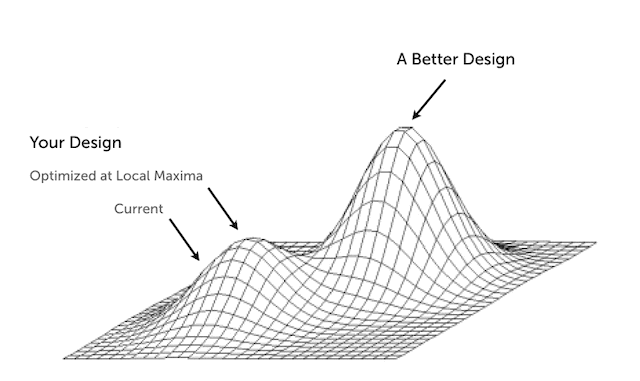To simplify how to think about the role of strategic planning, I’d like to share some basic lenses that have been helping me in my work over the last decade or so.
×
(1) STRATEGY WITH SOLID INFORMATION
If you’re lucky, you can get to work with reasonably solid information about your context. That’s the dream.
If you’re confident you have sufficient and reasonably reliable information, then you have a map, or can draw one. You’re now looking to understand, with the help of this map, your position in relation to the environment and to your (org’s) goals. As I already outlined in my newsletter a while back:
“Figure out where you are, what your goals are, and find your way there. The key is to zoom out and look at the larger landscape (not just a map!) and get your bearing. To decide where to focus attention.”
With the right map and awareness of what’s going on around you, you can orient yourself towards the peak you want to climb, the global maximum. And since you know where you are, what the environment is, and where that global maximum (your goal) is, you can now plot a path there. That’s your strategy. Follow it, and be ready to adjust and improvise as necessary.

×
(2) STRATEGY WITH IMPERFECT INFORMATION
More often than not, the available information might be imperfect: Incomplete, too low-resolution, too low-confidence. The map you have is too grainy or has too many blank spots to be a reliable tool.
So here, a different mode comes into play.
If you cannot necessarily see the global maximum, but only local maxima, it takes more effort. You see lower peaks all around you. They might be tempting to choose as targets because you can see them; but are they really where you’d like to go, and/or what’s behind them?
Where your map is too incomplete, you need a guiding star (values/principles) and a compass, to get roughly oriented. And you need even more awareness of what’s going on in your immediate environment. Instead of plotting a path and following it with minor adjustments (as shown above), this is something different entirely.
Here, you have to set off into the rough direction you need to go, and then improvise heavily. This means awareness and fast decision-making, constant adjustments: Of the path, the mode of transportation, maybe even the goals as you learn more. It’s a version akin to the proverbial crossing the river by feeling the stones.
×
One isn’t better than the other. They are different approaches to strategy development for different contexts. One is more front-loaded, more classically strategic. The other is more in-the-moment, with a stronger emphasis of tactical decision-making in the service of strategic goals.
We can see that the mega trends for now — global warming, digital transformation, political instability and a new fracturing globalization, and a pandemic on top — all share one thing: They increase uncertainty and volatility. So as we head deeper into the 21st century, I think it’s only reasonable to assume that this second mode I’ve described here will continue to become more and more important.
In order to get stuff done, an organization needs to know how to do both. And then learn how to recognize which one is appropriate for any given situation.


